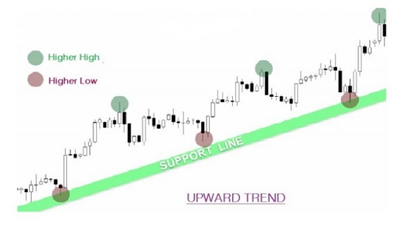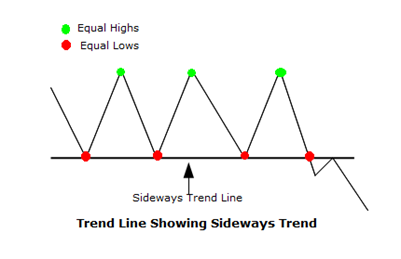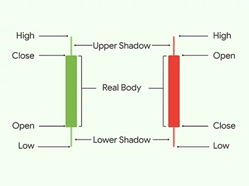信用取引戦略:トレンドに乗った取引
信用取引戦略の包括的な紹介です。トレンドと売買シグナルを見極め、賢く取引して利益を得ましょう。感情に左右されない 取引をしよう!
1. トレンドを見極める
トレンドとは上昇、下降、 あるいは横ばい等 相場が進む 方向性 の事です。
仮想通貨のトレンドの 出現は波の動きのようなもので、市場価格は一定方向にまっすぐ進むのではなく、トレンドの動きの軌跡は蛇行しながら進んでいきます。波の山と谷の位置関係により、上昇トレンド、下降トレンド、 横ばいトレンドに分けられます。
上昇トレンド: 山と谷が上昇を続け、前回の高値・安値を突破する事を指します。

下降トレンド: 山と谷が徐々に減少し、前回の高値/安値を下回る事を指します。

横ばいトレンド: トレンドの方向性が明確でない状態です。価格は支持線と抵抗線の間で上下に揺れています。

2.一方的な相場における取引戦略
相場が一方的に上昇または下降している場合、取引で利益を最大化するために、 取引で利益を最大化するために、バイ・アンド・ホールドやトレンド取引戦略等の 取引戦略を活用する事ができます。
トレンド取引は、通常数ヶ月以上という長期間にわたってポジションを保有するものです。トレンドトレーダーは、方向性のあるトレンドを利用して利益を得ようとします。上昇トレンドではロングし、下降トレンドではショートをします。温故知新、トレンドトレーダーは、相場の反転に注意する必要があります。
バイ・アンド・ホールド、トレーダーは、市場がどのように変動しても、長期的に保有する予定の資産を購入します。長期的に強気であれば、長期的な利益を増幅するために低レバレッジでロングをし、口座の安全性を確保するために負債比率を低く維持します。
メリット
1)弱気相場では、ショートで利益を上げる事ができます。
2)強気相場では、低レバレッジでロングする事により利益を伸ばす事ができます。
3)トレンドの方向がはっきりした後は、頻繁にチャートを見る必要がありません。
デメリット 長期戦略は横ばい相場には不向きです。そして、長期保有ポジションは、今後も関心を集めます。
3. 横ばい相場での売買戦略
相場が特定の価格帯で上下に振れる場合、ボラティリティバンドを短期・中期の取引に有効活用する事ができます。早期参入、早期撤退でバンドを利用した利益を得る事ができます。
短期売買とは、短期間で取引を行う事を指します。保有時間は通常、数時間から1日程度で、24時間以内です。短期トレーダーは、短期間で相場の動きを捉えようとします。超短期売買(スキャルピング)やデイトレードは、代表的な短期売買戦略です。
中期取引は、主にスイングトレードを指します。 保有期間は数日から数週間、一般的には24時間以上1ヶ月以下です。
超短期取引 (スキャルピング) は、最も高速な取引戦略の1つです。その基本的な考え方は、ポジションを長期間保有しない事です。超短期取引の焦点は、市場の小さな変化を繰り返し利用し、買値・売値・スプレッド、流動性ギャップ、または相場のその他の非効率性から利益を得る事です。
デイトレードは、トレーダーが通常24時間以内に完了する短期的な取引方法です。デイトレーダーの目標 は、日中の値動き(つまり、1取引日内の値動き)を利用する事です。
スイングトレード ポジションは1日以上、通常は数週間から1ヶ月以内、デイトレーディングとトレンドトレーディングの中間的な期間保有します。スイングトレーダーは中期トレーダーであり、長期トレーダーとデイトレーダーの中間に位置するトレーダーです。スイング・トレーダーは通常、 ボラティリティの変動を積極的に利用して取引を行い、横ばいの市場で利益を得るという目的を達成します。
スイングトレードを例に、インジケーターの知識を深めましょう。
4. スイングトレード
4.1 ローソク足チャートに関する事
ローソク足チャートは、ある一定期間の値動きをグラフ化したものです。その名の通り、ローソク足チャートはローソク足で構成されており、それぞれ が同じ時間を表しています。1分、15分、30分、60分、2H、4H、8H、1D、7Dチャート等を確認する事ができます。

各ローソク足チャートを作成する際には、以下の価格帯を設定する必要があります:
始値 - その特定期間内に記録された銘柄の最初の取引価格を指します。
高値 - その特定期間内に記録されたその銘柄の最高取引価格を指します。
安値 - その特定期間内に記録されたその銘柄の最低取引価格を指します。
終値-その特定期間内に記録されたその銘柄の最後の取引価格を指します。
4.2 ローソク足チャートにおける前回の高値と前回の安値

4.3 ローソク足チャートで最適なポイントを探す
支持線と抵抗線
移動平均線の一定期間の最安値が支持線、一定期間の最高値が抵抗線です。一般的に、取引に最適な売買ポイントは、支持線・抵抗線付近でもあります。
買いシグナルと売りシグナル
チャートパターンと移動平均線の支持・抵抗線によって、現在のトレンドを予測・判断する事ができます。トレンドが明確になった後、最適な売買ポイントを選択する必要があります。より良いポイントは、利益の幅を広げるだけでなく、取引のリスクを大幅に軽減する事ができます。
利食いと損切りのポイント
リスク管理は合理的な取引戦略の中に含まれる必要があり、どのような取引においても利益と損失を時間内に止める事をお勧めします。利食いは利益が出ている部分を決済し、その後の市場の変化 による 利益の減少、あるいは損失を避ける事ができ、損切りは損失のさらなる拡大を避け、リスクを許容範囲内にコントロールする事ができます。
メリット :
1) 上昇トレンド、 下降トレンド、横ばい等、あらゆる相場の状況に対応します。波があり、利益の機会があります。早期参入、早期撤退で終了し、利益を得る事ができます。
2) 横ばい相場では、スイングトレードは 長期保有資金の稼働率を高め、積極的に資産を増やす良い方法です。
3)スイングを利用して最適な売買シグナルを見つけ、;利益を増幅させ、最適なポジションで利食いと損切りを行う事ができます。
デメリット:
スイングトレードは、テクニカル分析やツールに関する知識が必要です。
ヒント:
1. 取引戦略には多くの種類がありますので、; よく調べて取引戦略を立ててください;
2. 信用取引はリスクが高いので レバレッジを低く設定し、取引リスクをコントロールすることをお勧めします。

